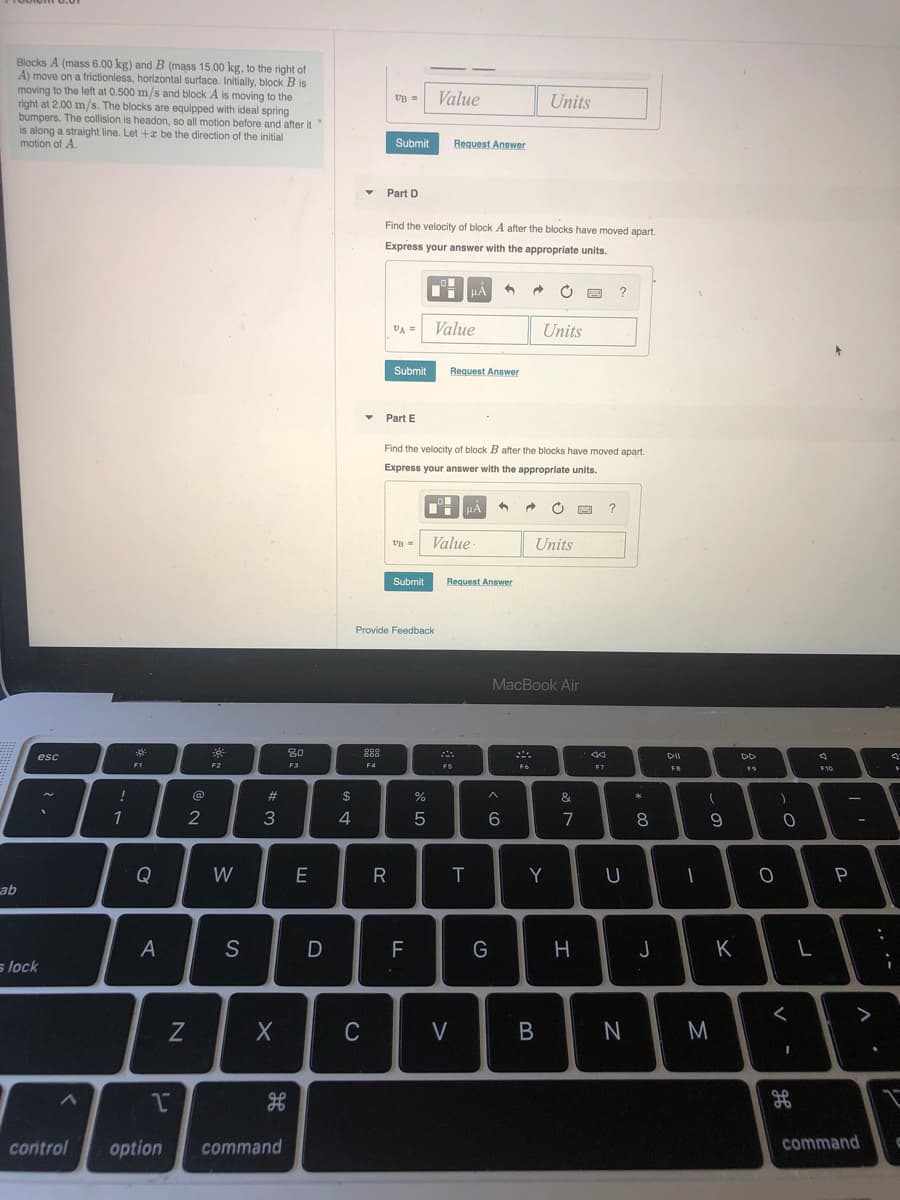Blocks A (mass 6.00 kg) and B (mass 15.00 kg, to the right of A) move on a frictionless, horizontal surface. Initially, block B is moving to the left at 0.500 m/s and block A is moving to the right at 2.00 m/s. The blocks are equipped with ideal spring bumpers. The collision is headon, so all motion before and after it is along a straight line. Let +z be the direction of the initial motion of A. Value Units Submit Request Answer Part D Find the velocity of block A after the blocks have moved apart. Express your answer with the appropriate units. HẢ ? Value Units Submit Request Answer Part E Find the velocity of block B ater the blocks have moved apart. Express your answer with the appropriate units. HA Value Units Submit Request Answer Provide Feedback
Blocks A (mass 6.00 kg) and B (mass 15.00 kg, to the right of A) move on a frictionless, horizontal surface. Initially, block B is moving to the left at 0.500 m/s and block A is moving to the right at 2.00 m/s. The blocks are equipped with ideal spring bumpers. The collision is headon, so all motion before and after it is along a straight line. Let +z be the direction of the initial motion of A. Value Units Submit Request Answer Part D Find the velocity of block A after the blocks have moved apart. Express your answer with the appropriate units. HẢ ? Value Units Submit Request Answer Part E Find the velocity of block B ater the blocks have moved apart. Express your answer with the appropriate units. HA Value Units Submit Request Answer Provide Feedback
An Introduction to Physical Science
14th Edition
ISBN:9781305079137
Author:James Shipman, Jerry D. Wilson, Charles A. Higgins, Omar Torres
Publisher:James Shipman, Jerry D. Wilson, Charles A. Higgins, Omar Torres
Chapter10: Nuclear Physics
Section: Chapter Questions
Problem 21SA
Related questions
Question

Transcribed Image Text:Blocks A (mass 6.00 kg) and B (mass 15.00 kg, to the right of
A) move on a frictionless, horizontal surface. Initially, block B is
moving to the left at 0.500 m/s and block A is moving to the
right at 2.00 m/s. The blocks are equipped with ideal spring
bumpers. The collision is headon, so all motion before and after it
is along a straight line. Let +x be the direction of the initial
motion of A.
VB =
Value
Units
Submit
Request Answer
Part D
Find the velocity of block A after the blocks have moved apart.
Express your answer with the appropriate units.
Value
VA =
Units
Submit
Request Answer
• Part E
Find the velocity of block B after the blocks have moved apart.
Express your answer with the appropriate units.
Value
Units
UB =
Submit
Request Answer
Provide Feedback
MacBook Air
80
esc
DII
DD
FI
F3
F4
F7
FB
19
F10
#3
$
%
1
2
4
7
8
9.
Q
W
R
T
Y
P
ab
A
S
F
G
J
K
s lock
C
V
M
control
option
command
command

Transcribed Image Text:<Homework 6
Problem 8.67
Blocks A (mass 6.00 kg) and B (mass 15.00 kg, to the right of
A) move on a frictionless, horizontal surface. Initially, block B is
moving to the left at 0.500 m/s and block A is moving to the
right at 2.00 m/s. The blocks are equipped with ideal spring
bumpers. The collision is headon, so all motion before and after it
is along a straight line. Let +z be the direction of the initial
motion of A.
Part A
Find the maximum energy stored in the spring bumpers.
Express your answer with the appropriate units.
Ugring max =
-Value
Units
Submit
Request Answer
• Part B
Find the velocity of block A when the energy stored in the spring bumpers is maximum.
Express your answer with the appropriate units.
?
VA =
Value
Units
Submit
Request Answer
Part C
Find the velocity of block B when the energy stored in the spring bumpers is maximum.
Express your answer with the appropriate units.
?
MacBook Air
80
888
F4
esc
DD
F1
FZ
F3
F5
F7
FB
F10
%23
$
(
1
2
3
4.
7
8
Q
W
R
T
Y
U
tab
A
S
F
J
K
caps lock
<>
C
V
ft
1
control
option
command
command
B
%24
Expert Solution
This question has been solved!
Explore an expertly crafted, step-by-step solution for a thorough understanding of key concepts.
Step by step
Solved in 2 steps with 1 images

Knowledge Booster
Learn more about
Need a deep-dive on the concept behind this application? Look no further. Learn more about this topic, physics and related others by exploring similar questions and additional content below.Recommended textbooks for you

An Introduction to Physical Science
Physics
ISBN:
9781305079137
Author:
James Shipman, Jerry D. Wilson, Charles A. Higgins, Omar Torres
Publisher:
Cengage Learning

An Introduction to Physical Science
Physics
ISBN:
9781305079137
Author:
James Shipman, Jerry D. Wilson, Charles A. Higgins, Omar Torres
Publisher:
Cengage Learning